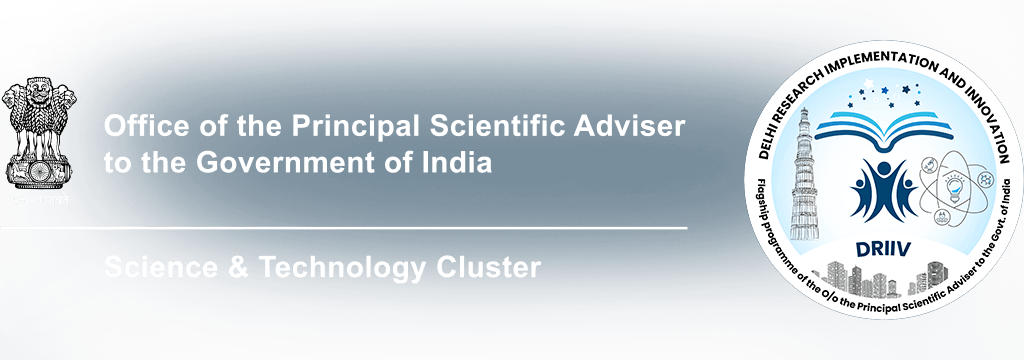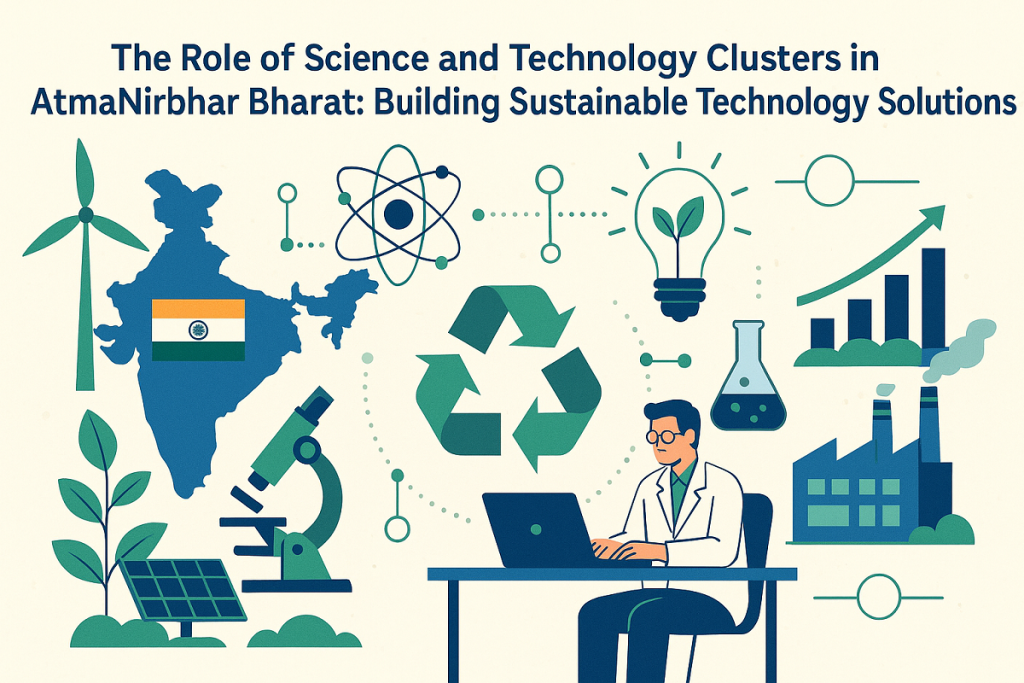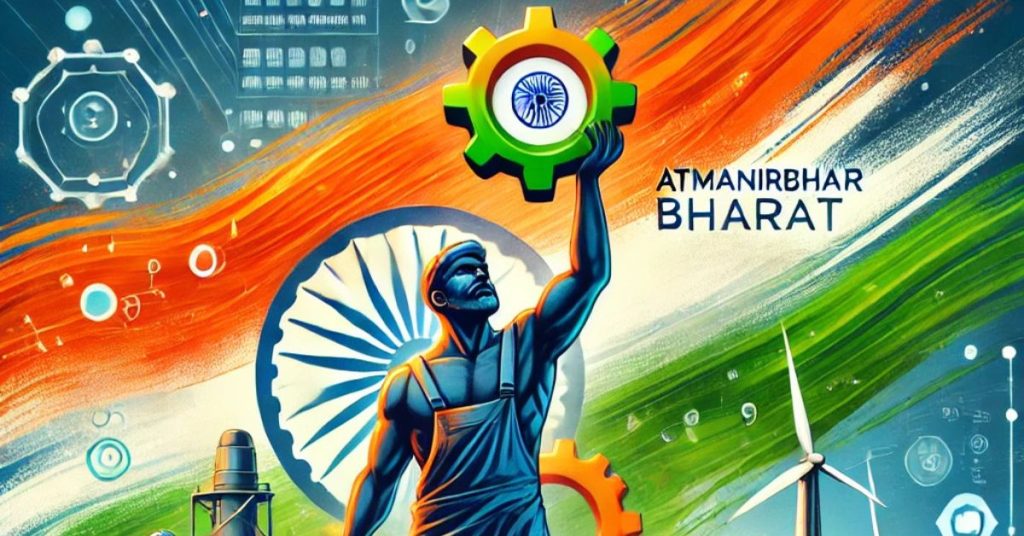In today’s rapidly evolving world, the role of science and technology cluster is more important than ever. India, as a growing global leader, recognizes the need to leverage innovation to foster self-reliance and sustainability. With initiatives like AtmaNirbhar Bharat (Self-Reliant India), India is striving to create a robust ecosystem for innovation and sustainable growth. One such powerful driver of innovation is the Science and Technology Cluster (S&T Cluster), which plays a pivotal role in building sustainable technology solutions and ensuring long-term environmental benefits.
In this blog, we will explore the significance of Science and Technology Clusters, their alignment with AtmaNirbhar Bharat, and their contribution to Sustainable Technology Solutions that support Science for Sustainability.
What is a Science and Technology Cluster?
A Science and Technology Cluster refers to a collaborative ecosystem where scientists, researchers, innovators, and businesses come together to exchange ideas, share knowledge, and work on cutting-edge technologies. These clusters are designed to foster innovation, promote research and development (R&D), and accelerate the commercialization of new technologies. They are hubs of innovation that bring together various stakeholders to create scalable, impactful solutions in areas such as energy, healthcare, agriculture, and environmental sustainability.
AtmaNirbhar Bharat and Its Connection with S&T Clusters
AtmaNirbhar Bharat, or Self-Reliant India, is an initiative launched by the Government of India to encourage domestic manufacturing, reduce dependency on imports, and promote innovation and entrepreneurship. The vision behind AtmaNirbhar Bharat is to make India self-sufficient in key sectors by harnessing the power of indigenous innovation and technology.
S&T Clusters play a crucial role in this initiative. By creating an environment where collaboration between various stakeholders is encouraged, these clusters become the breeding grounds for indigenous innovations that can meet India’s needs. From renewable energy solutions to digital healthcare technologies, the S&T Cluster acts as the backbone of India’s mission to become self-reliant.
In this context, S&T Clusters help in:
- Promoting homegrown technologies.
- Supporting research in key areas like green energy and sustainable practices.
- Encouraging public-private partnerships that boost industrial growth.
- Reducing dependency on foreign technologies by fostering indigenous solutions.
Thus, the role of S&T Clusters in achieving the goals of AtmaNirbhar Bharat is indispensable.
The Importance of Sustainable Technology Solutions
As the world faces the dual challenges of climate change and resource depletion, there is an urgent need for Sustainable Technology Solutions. These solutions not only help in reducing the environmental impact of industries but also ensure that development is balanced with ecological conservation.
Sustainable Technology Solutions encompass innovations in renewable energy, waste management, water purification, sustainable agriculture, and more. They aim to reduce the negative environmental impact while promoting economic growth.
Here are some examples of Sustainable Technology Solutions that are being developed and implemented within S&T Clusters in India:
Renewable Energy Technologies: Solar power, wind energy, and biofuels are just some of the renewable energy solutions being developed within these clusters. By focusing on green energy, India can reduce its reliance on fossil fuels and decrease carbon emissions.
Water Management Systems: Innovations in water purification, desalination, and efficient irrigation are being explored in many S&T Clusters. These technologies are essential for ensuring sustainable water use in a country where water scarcity is a growing concern.
Waste-to-Energy Technologies: Converting waste into energy is a major breakthrough in sustainable technology. Several clusters in India are focusing on waste management solutions that can contribute to cleaner cities and reduce landfill waste.
Sustainable Agriculture: Technologies that increase crop yield while minimizing water and chemical use are a critical part of sustainable agriculture. Precision farming and agro-technology innovations are paving the way for environmentally friendly farming practices.
Through these sustainable solutions, India is working towards building a greener and more self-sufficient future.
Science for Sustainability: Paving the Path to a Greener Future
Science for Sustainability refers to the application of scientific knowledge to create technologies and systems that support environmental conservation while fostering economic and social development. By harnessing the power of science, we can develop innovative solutions to global challenges such as climate change, resource scarcity, and ecosystem degradation.
In India, S&T Clusters are at the heart of this movement, as they provide the platform for scientists, researchers, and entrepreneurs to collaborate on developing new technologies that promote sustainable practices. Some key areas where Science for Sustainability is making a significant impact include:
Climate Change Mitigation: Developing technologies that reduce carbon footprints, improve energy efficiency, and encourage the use of clean energy sources.
Biodiversity Conservation: Using data science, AI, and other technologies to monitor and protect biodiversity and ecosystems.
Circular Economy: Fostering a circular economy model that reduces waste and promotes the reuse of resources. This model can be supported by S&T Clusters, where innovations in recycling, waste management, and upcycling are being developed.
Carbon Capture and Storage (CCS): Scientists in these clusters are also working on technologies that can capture and store carbon dioxide emissions to combat global warming.
Through Science for Sustainability, India is poised to make significant strides in reducing its environmental impact while continuing to grow economically.
How S&T Clusters Contribute to Sustainable Development Goals (SDGs)
S&T Clusters contribute directly to the achievement of several Sustainable Development Goals (SDGs) set by the United Nations. These include:
Goal 7: Affordable and Clean Energy – By advancing renewable energy technologies.
Goal 12: Responsible Consumption and Production – By developing sustainable manufacturing processes and materials.
Goal 13: Climate Action – By creating solutions for climate change mitigation and adaptation.
Goal 6: Clean Water and Sanitation – By improving water conservation and purification technologies.
Goal 9: Industry, Innovation, and Infrastructure – By driving technological innovation and infrastructure development.
These goals align with India’s long-term vision of sustainable development, which is supported through the collaborative efforts of S&T Clusters.
Conclusion
India’s focus on AtmaNirbhar Bharat and Science and Technology Clusters is crucial for the nation’s growth in an environmentally sustainable manner. By promoting innovation, collaboration, and the development of Sustainable Technology Solutions, India is paving the way for a greener, self-reliant future. The combination of Science for Sustainability and the power of S&T Clusters is what will drive India’s progress towards achieving its sustainability goals.
As we move forward, it is clear that S&T Clusters are not just a hub for technological advancement—they are the key to building a better, more sustainable future for all.
Frequently Asked Questions (FAQs)
What is a Science and Technology Cluster (S&T Cluster)?
A Science and Technology Cluster is a collaborative environment where innovators, researchers, and businesses come together to develop and commercialize new technologies. These clusters foster innovation, research, and development, contributing to sustainable solutions in various industries.
How does AtmaNirbhar Bharat relate to S&T Clusters?
AtmaNirbhar Bharat aims to make India self-reliant, and S&T Clusters contribute by developing indigenous technologies that reduce dependency on imports, encourage innovation, and promote homegrown solutions for critical sectors.
What are Sustainable Technology Solutions?
Sustainable Technology Solutions are innovations designed to minimize environmental impact, such as renewable energy technologies, efficient water management systems, and waste-to-energy solutions. These solutions promote sustainable development by balancing ecological conservation with economic growth.
How can Science for Sustainability help in India’s growth?
Science for Sustainability applies scientific knowledge to create technologies that address global challenges like climate change, resource depletion, and ecosystem protection. It plays a critical role in India’s efforts to reduce its environmental impact and foster a sustainable future.
How do S&T Clusters contribute to Sustainable Development Goals (SDGs)?
S&T Clusters contribute to several SDGs by advancing clean energy, improving waste management, promoting climate action, and driving innovation in areas like water conservation and biodiversity protection.




